Information Systems and Big Data Analysis: Comprehensive Report
VerifiedAdded on 2023/06/07
|8
|1965
|152
Report
AI Summary
This report provides a comprehensive analysis of information systems and big data, beginning with a historical overview and defining big data along with its key characteristics: volume, value, velocity, veracity, and variability. It delves into the challenges of big data analytics, such as failing to provide timely insights, inaccurate analytics, scaling issues, incorrect integration, heavy expenses, and real-time data demands. The report also explores various techniques for analyzing big data, including A/B testing, data fusion and integration, data mining, machine learning, statistics, and natural language processing. Furthermore, it discusses how big data technologies can support businesses by reducing costs and improving decision-making, using examples like optimizing operations and pricing strategies. The report concludes that big data helps companies improve efficiency, optimize costs, foster innovation, and identify potential risks.
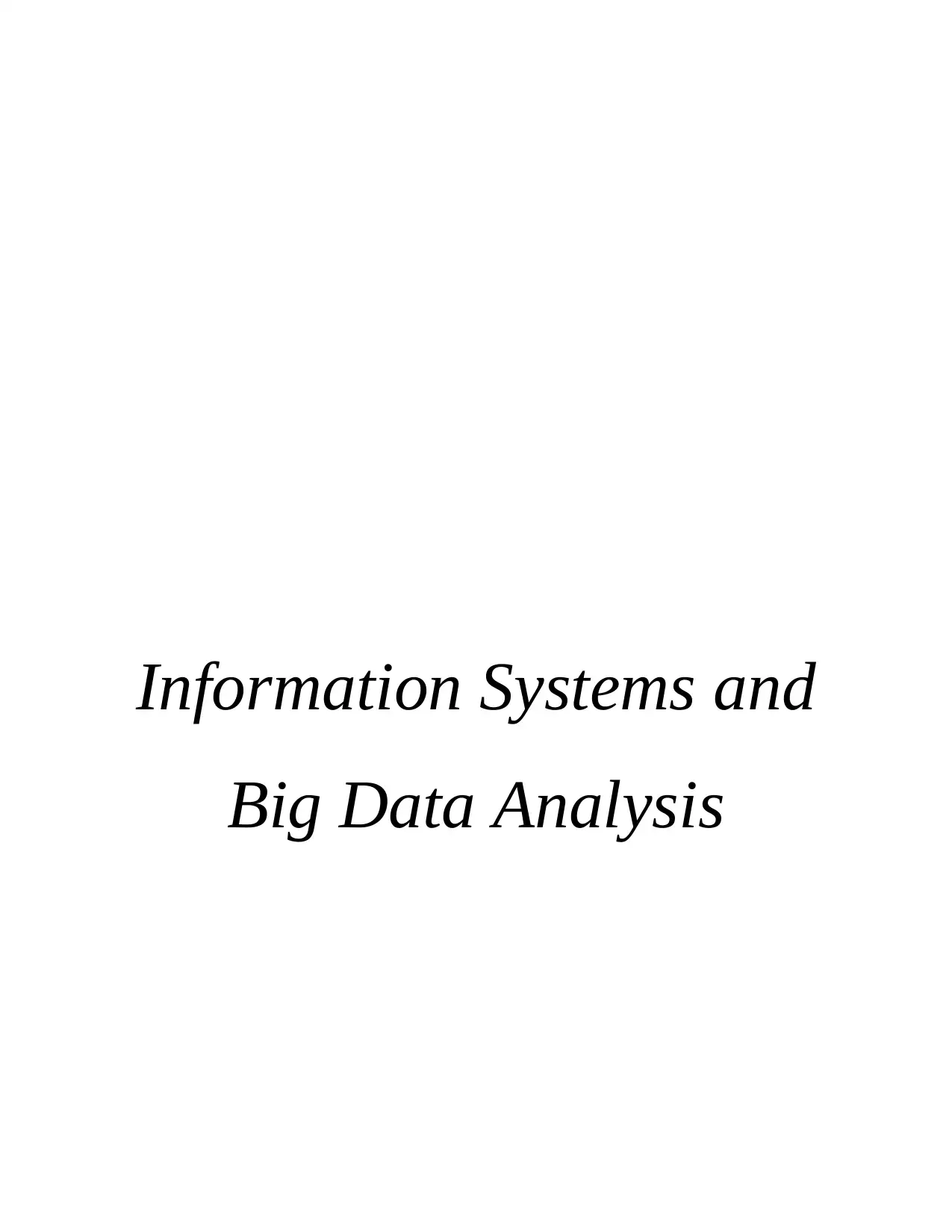
Information Systems and
Big Data Analysis
Big Data Analysis
Paraphrase This Document
Need a fresh take? Get an instant paraphrase of this document with our AI Paraphraser
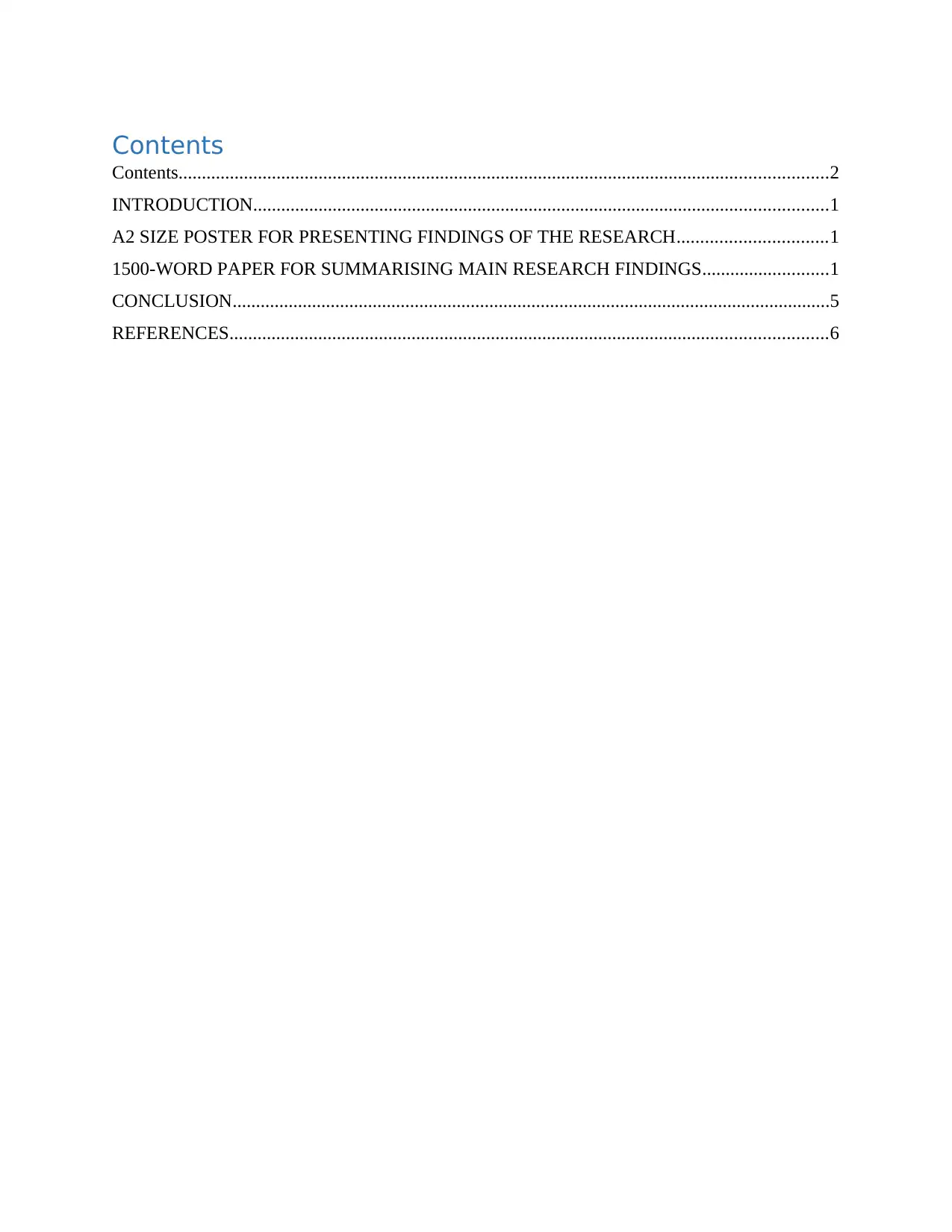
Contents
Contents...........................................................................................................................................2
INTRODUCTION...........................................................................................................................1
A2 SIZE POSTER FOR PRESENTING FINDINGS OF THE RESEARCH................................1
1500-WORD PAPER FOR SUMMARISING MAIN RESEARCH FINDINGS...........................1
CONCLUSION................................................................................................................................5
REFERENCES................................................................................................................................6
Contents...........................................................................................................................................2
INTRODUCTION...........................................................................................................................1
A2 SIZE POSTER FOR PRESENTING FINDINGS OF THE RESEARCH................................1
1500-WORD PAPER FOR SUMMARISING MAIN RESEARCH FINDINGS...........................1
CONCLUSION................................................................................................................................5
REFERENCES................................................................................................................................6
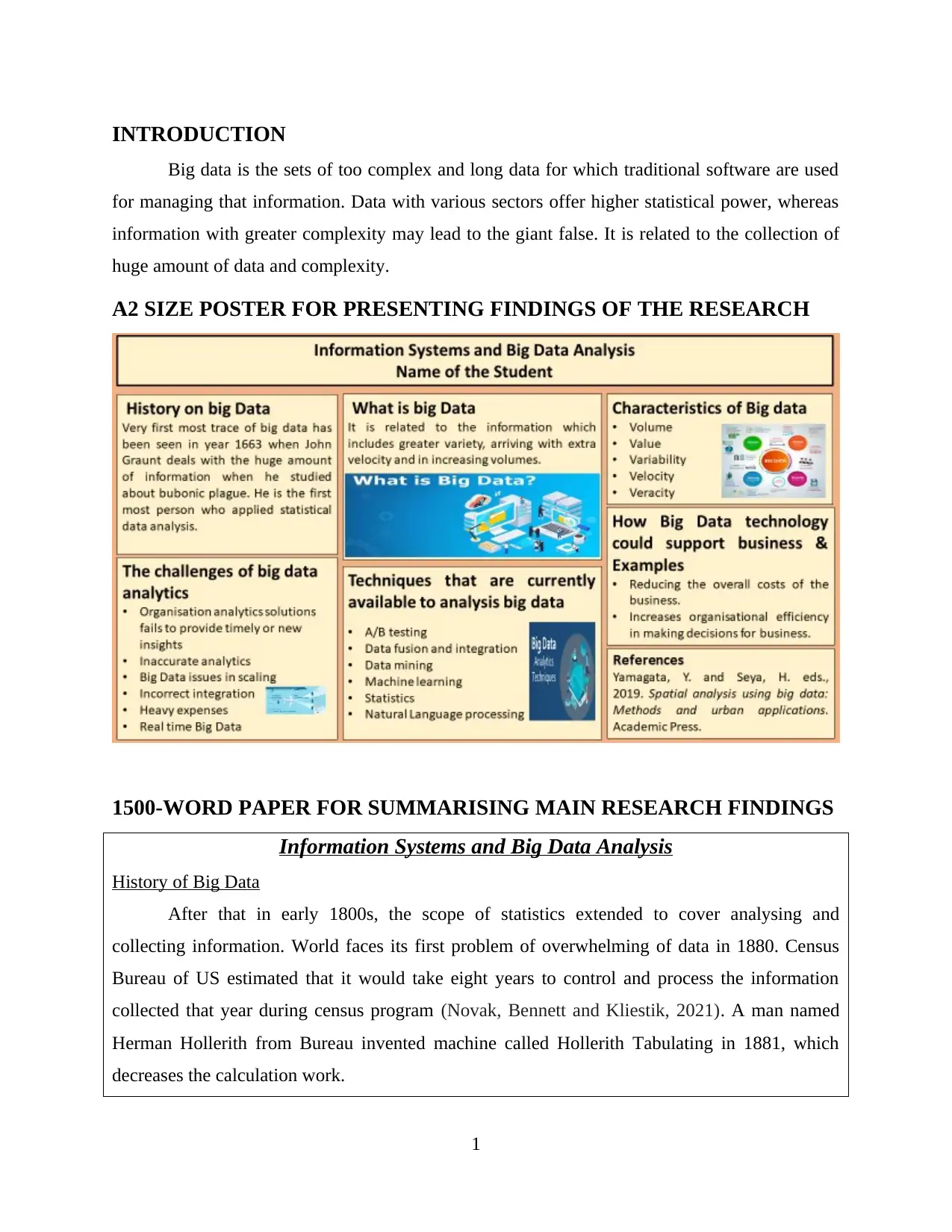
INTRODUCTION
Big data is the sets of too complex and long data for which traditional software are used
for managing that information. Data with various sectors offer higher statistical power, whereas
information with greater complexity may lead to the giant false. It is related to the collection of
huge amount of data and complexity.
A2 SIZE POSTER FOR PRESENTING FINDINGS OF THE RESEARCH
1500-WORD PAPER FOR SUMMARISING MAIN RESEARCH FINDINGS
Information Systems and Big Data Analysis
History of Big Data
After that in early 1800s, the scope of statistics extended to cover analysing and
collecting information. World faces its first problem of overwhelming of data in 1880. Census
Bureau of US estimated that it would take eight years to control and process the information
collected that year during census program (Novak, Bennett and Kliestik, 2021). A man named
Herman Hollerith from Bureau invented machine called Hollerith Tabulating in 1881, which
decreases the calculation work.
1
Big data is the sets of too complex and long data for which traditional software are used
for managing that information. Data with various sectors offer higher statistical power, whereas
information with greater complexity may lead to the giant false. It is related to the collection of
huge amount of data and complexity.
A2 SIZE POSTER FOR PRESENTING FINDINGS OF THE RESEARCH
1500-WORD PAPER FOR SUMMARISING MAIN RESEARCH FINDINGS
Information Systems and Big Data Analysis
History of Big Data
After that in early 1800s, the scope of statistics extended to cover analysing and
collecting information. World faces its first problem of overwhelming of data in 1880. Census
Bureau of US estimated that it would take eight years to control and process the information
collected that year during census program (Novak, Bennett and Kliestik, 2021). A man named
Herman Hollerith from Bureau invented machine called Hollerith Tabulating in 1881, which
decreases the calculation work.
1
⊘ This is a preview!⊘
Do you want full access?
Subscribe today to unlock all pages.

Trusted by 1+ million students worldwide
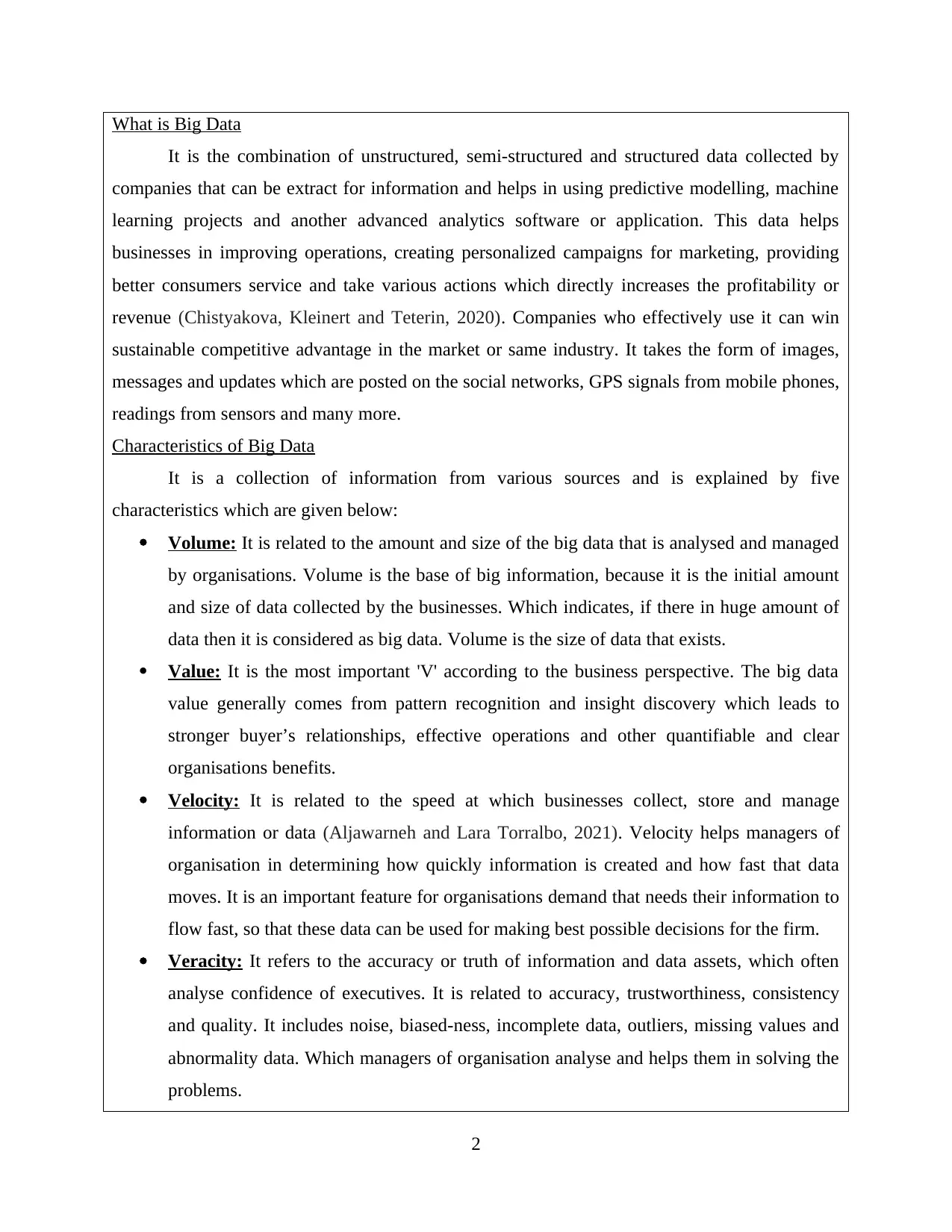
What is Big Data
It is the combination of unstructured, semi-structured and structured data collected by
companies that can be extract for information and helps in using predictive modelling, machine
learning projects and another advanced analytics software or application. This data helps
businesses in improving operations, creating personalized campaigns for marketing, providing
better consumers service and take various actions which directly increases the profitability or
revenue (Chistyakova, Kleinert and Teterin, 2020). Companies who effectively use it can win
sustainable competitive advantage in the market or same industry. It takes the form of images,
messages and updates which are posted on the social networks, GPS signals from mobile phones,
readings from sensors and many more.
Characteristics of Big Data
It is a collection of information from various sources and is explained by five
characteristics which are given below:
Volume: It is related to the amount and size of the big data that is analysed and managed
by organisations. Volume is the base of big information, because it is the initial amount
and size of data collected by the businesses. Which indicates, if there in huge amount of
data then it is considered as big data. Volume is the size of data that exists.
Value: It is the most important 'V' according to the business perspective. The big data
value generally comes from pattern recognition and insight discovery which leads to
stronger buyer’s relationships, effective operations and other quantifiable and clear
organisations benefits.
Velocity: It is related to the speed at which businesses collect, store and manage
information or data (Aljawarneh and Lara Torralbo, 2021). Velocity helps managers of
organisation in determining how quickly information is created and how fast that data
moves. It is an important feature for organisations demand that needs their information to
flow fast, so that these data can be used for making best possible decisions for the firm.
Veracity: It refers to the accuracy or truth of information and data assets, which often
analyse confidence of executives. It is related to accuracy, trustworthiness, consistency
and quality. It includes noise, biased-ness, incomplete data, outliers, missing values and
abnormality data. Which managers of organisation analyse and helps them in solving the
problems.
2
It is the combination of unstructured, semi-structured and structured data collected by
companies that can be extract for information and helps in using predictive modelling, machine
learning projects and another advanced analytics software or application. This data helps
businesses in improving operations, creating personalized campaigns for marketing, providing
better consumers service and take various actions which directly increases the profitability or
revenue (Chistyakova, Kleinert and Teterin, 2020). Companies who effectively use it can win
sustainable competitive advantage in the market or same industry. It takes the form of images,
messages and updates which are posted on the social networks, GPS signals from mobile phones,
readings from sensors and many more.
Characteristics of Big Data
It is a collection of information from various sources and is explained by five
characteristics which are given below:
Volume: It is related to the amount and size of the big data that is analysed and managed
by organisations. Volume is the base of big information, because it is the initial amount
and size of data collected by the businesses. Which indicates, if there in huge amount of
data then it is considered as big data. Volume is the size of data that exists.
Value: It is the most important 'V' according to the business perspective. The big data
value generally comes from pattern recognition and insight discovery which leads to
stronger buyer’s relationships, effective operations and other quantifiable and clear
organisations benefits.
Velocity: It is related to the speed at which businesses collect, store and manage
information or data (Aljawarneh and Lara Torralbo, 2021). Velocity helps managers of
organisation in determining how quickly information is created and how fast that data
moves. It is an important feature for organisations demand that needs their information to
flow fast, so that these data can be used for making best possible decisions for the firm.
Veracity: It refers to the accuracy or truth of information and data assets, which often
analyse confidence of executives. It is related to accuracy, trustworthiness, consistency
and quality. It includes noise, biased-ness, incomplete data, outliers, missing values and
abnormality data. Which managers of organisation analyse and helps them in solving the
problems.
2
Paraphrase This Document
Need a fresh take? Get an instant paraphrase of this document with our AI Paraphraser
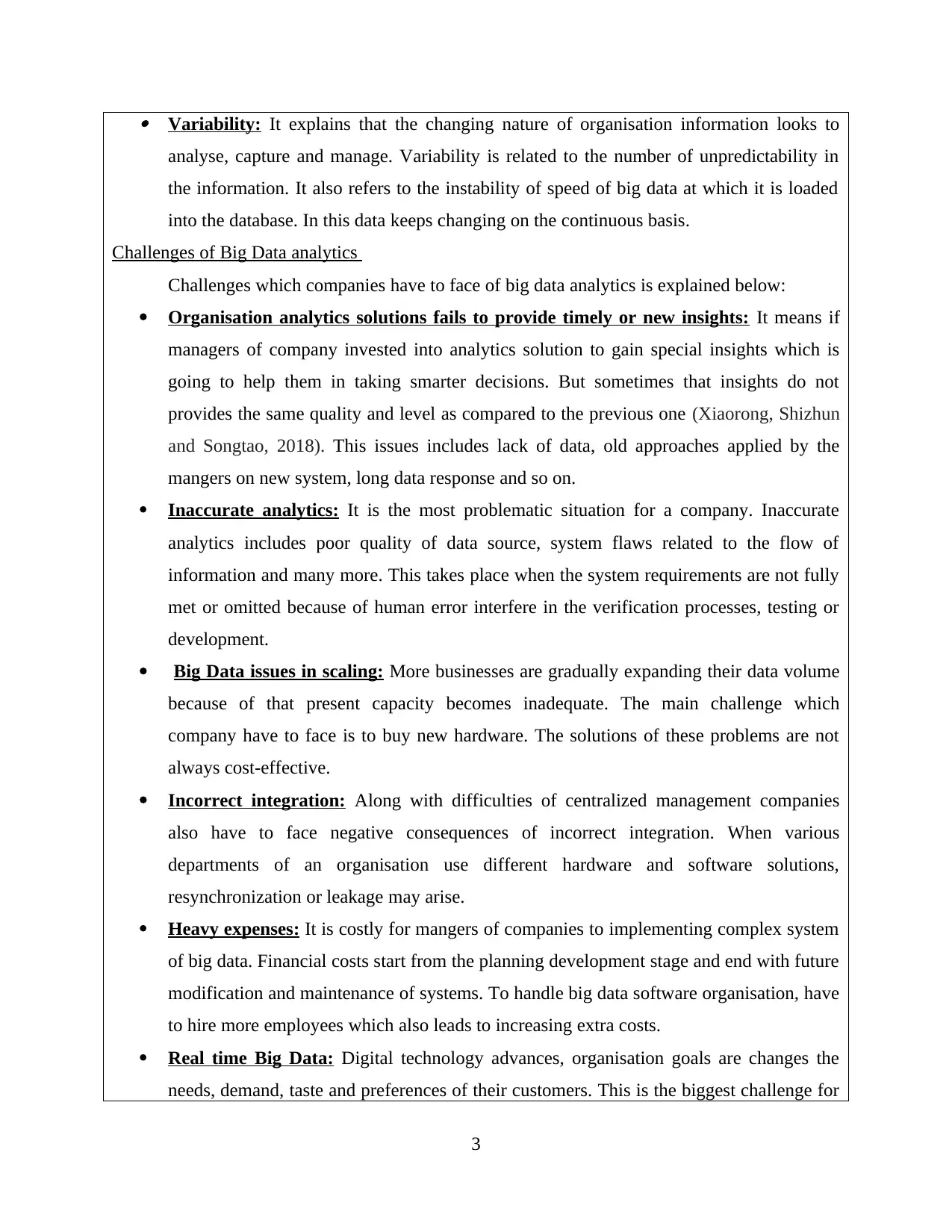
Variability: It explains that the changing nature of organisation information looks to
analyse, capture and manage. Variability is related to the number of unpredictability in
the information. It also refers to the instability of speed of big data at which it is loaded
into the database. In this data keeps changing on the continuous basis.
Challenges of Big Data analytics
Challenges which companies have to face of big data analytics is explained below:
Organisation analytics solutions fails to provide timely or new insights: It means if
managers of company invested into analytics solution to gain special insights which is
going to help them in taking smarter decisions. But sometimes that insights do not
provides the same quality and level as compared to the previous one (Xiaorong, Shizhun
and Songtao, 2018). This issues includes lack of data, old approaches applied by the
mangers on new system, long data response and so on.
Inaccurate analytics: It is the most problematic situation for a company. Inaccurate
analytics includes poor quality of data source, system flaws related to the flow of
information and many more. This takes place when the system requirements are not fully
met or omitted because of human error interfere in the verification processes, testing or
development.
Big Data issues in scaling: More businesses are gradually expanding their data volume
because of that present capacity becomes inadequate. The main challenge which
company have to face is to buy new hardware. The solutions of these problems are not
always cost-effective.
Incorrect integration: Along with difficulties of centralized management companies
also have to face negative consequences of incorrect integration. When various
departments of an organisation use different hardware and software solutions,
resynchronization or leakage may arise.
Heavy expenses: It is costly for mangers of companies to implementing complex system
of big data. Financial costs start from the planning development stage and end with future
modification and maintenance of systems. To handle big data software organisation, have
to hire more employees which also leads to increasing extra costs.
Real time Big Data: Digital technology advances, organisation goals are changes the
needs, demand, taste and preferences of their customers. This is the biggest challenge for
3
analyse, capture and manage. Variability is related to the number of unpredictability in
the information. It also refers to the instability of speed of big data at which it is loaded
into the database. In this data keeps changing on the continuous basis.
Challenges of Big Data analytics
Challenges which companies have to face of big data analytics is explained below:
Organisation analytics solutions fails to provide timely or new insights: It means if
managers of company invested into analytics solution to gain special insights which is
going to help them in taking smarter decisions. But sometimes that insights do not
provides the same quality and level as compared to the previous one (Xiaorong, Shizhun
and Songtao, 2018). This issues includes lack of data, old approaches applied by the
mangers on new system, long data response and so on.
Inaccurate analytics: It is the most problematic situation for a company. Inaccurate
analytics includes poor quality of data source, system flaws related to the flow of
information and many more. This takes place when the system requirements are not fully
met or omitted because of human error interfere in the verification processes, testing or
development.
Big Data issues in scaling: More businesses are gradually expanding their data volume
because of that present capacity becomes inadequate. The main challenge which
company have to face is to buy new hardware. The solutions of these problems are not
always cost-effective.
Incorrect integration: Along with difficulties of centralized management companies
also have to face negative consequences of incorrect integration. When various
departments of an organisation use different hardware and software solutions,
resynchronization or leakage may arise.
Heavy expenses: It is costly for mangers of companies to implementing complex system
of big data. Financial costs start from the planning development stage and end with future
modification and maintenance of systems. To handle big data software organisation, have
to hire more employees which also leads to increasing extra costs.
Real time Big Data: Digital technology advances, organisation goals are changes the
needs, demand, taste and preferences of their customers. This is the biggest challenge for
3
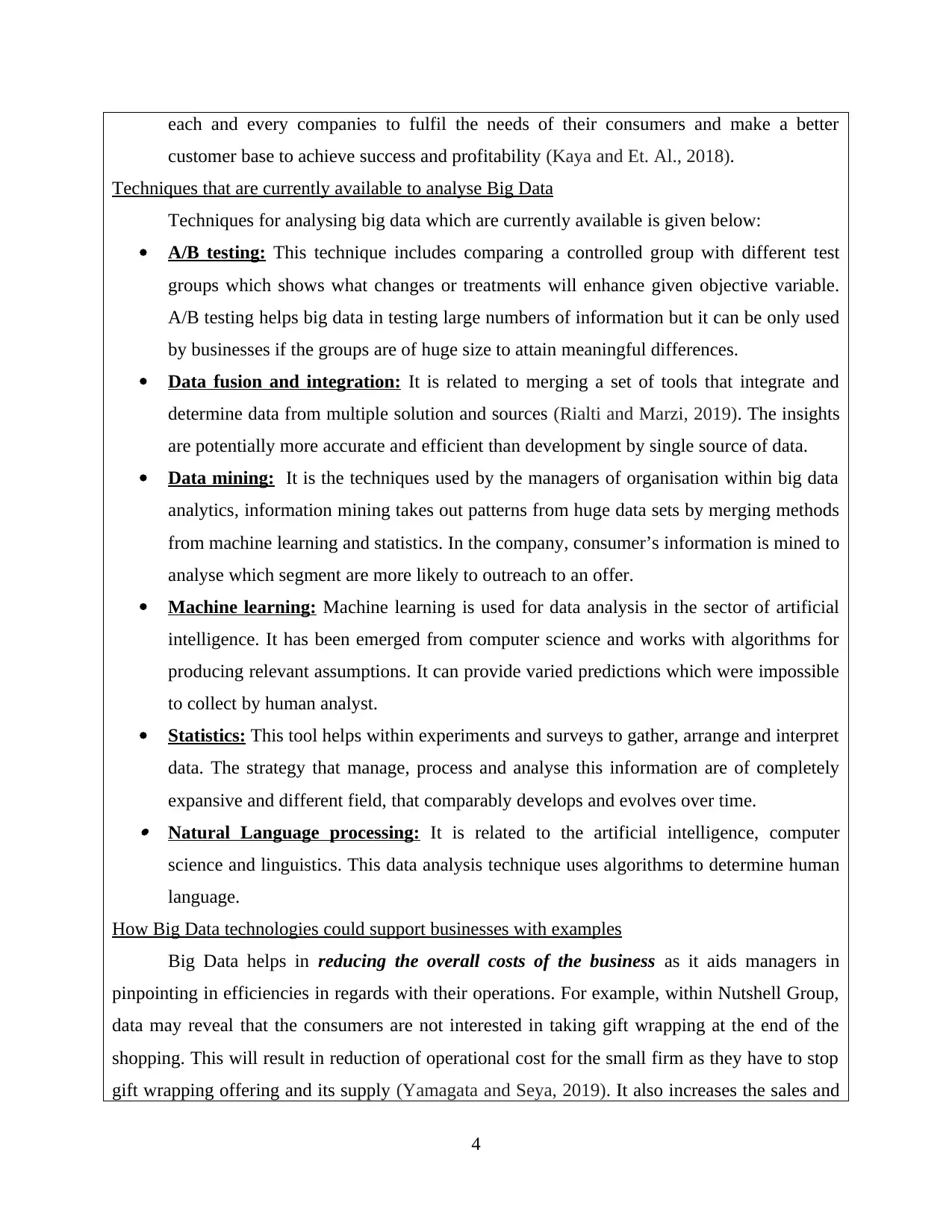
each and every companies to fulfil the needs of their consumers and make a better
customer base to achieve success and profitability (Kaya and Et. Al., 2018).
Techniques that are currently available to analyse Big Data
Techniques for analysing big data which are currently available is given below:
A/B testing: This technique includes comparing a controlled group with different test
groups which shows what changes or treatments will enhance given objective variable.
A/B testing helps big data in testing large numbers of information but it can be only used
by businesses if the groups are of huge size to attain meaningful differences.
Data fusion and integration: It is related to merging a set of tools that integrate and
determine data from multiple solution and sources (Rialti and Marzi, 2019). The insights
are potentially more accurate and efficient than development by single source of data.
Data mining: It is the techniques used by the managers of organisation within big data
analytics, information mining takes out patterns from huge data sets by merging methods
from machine learning and statistics. In the company, consumer’s information is mined to
analyse which segment are more likely to outreach to an offer.
Machine learning: Machine learning is used for data analysis in the sector of artificial
intelligence. It has been emerged from computer science and works with algorithms for
producing relevant assumptions. It can provide varied predictions which were impossible
to collect by human analyst.
Statistics: This tool helps within experiments and surveys to gather, arrange and interpret
data. The strategy that manage, process and analyse this information are of completely
expansive and different field, that comparably develops and evolves over time. Natural Language processing: It is related to the artificial intelligence, computer
science and linguistics. This data analysis technique uses algorithms to determine human
language.
How Big Data technologies could support businesses with examples
Big Data helps in reducing the overall costs of the business as it aids managers in
pinpointing in efficiencies in regards with their operations. For example, within Nutshell Group,
data may reveal that the consumers are not interested in taking gift wrapping at the end of the
shopping. This will result in reduction of operational cost for the small firm as they have to stop
gift wrapping offering and its supply (Yamagata and Seya, 2019). It also increases the sales and
4
customer base to achieve success and profitability (Kaya and Et. Al., 2018).
Techniques that are currently available to analyse Big Data
Techniques for analysing big data which are currently available is given below:
A/B testing: This technique includes comparing a controlled group with different test
groups which shows what changes or treatments will enhance given objective variable.
A/B testing helps big data in testing large numbers of information but it can be only used
by businesses if the groups are of huge size to attain meaningful differences.
Data fusion and integration: It is related to merging a set of tools that integrate and
determine data from multiple solution and sources (Rialti and Marzi, 2019). The insights
are potentially more accurate and efficient than development by single source of data.
Data mining: It is the techniques used by the managers of organisation within big data
analytics, information mining takes out patterns from huge data sets by merging methods
from machine learning and statistics. In the company, consumer’s information is mined to
analyse which segment are more likely to outreach to an offer.
Machine learning: Machine learning is used for data analysis in the sector of artificial
intelligence. It has been emerged from computer science and works with algorithms for
producing relevant assumptions. It can provide varied predictions which were impossible
to collect by human analyst.
Statistics: This tool helps within experiments and surveys to gather, arrange and interpret
data. The strategy that manage, process and analyse this information are of completely
expansive and different field, that comparably develops and evolves over time. Natural Language processing: It is related to the artificial intelligence, computer
science and linguistics. This data analysis technique uses algorithms to determine human
language.
How Big Data technologies could support businesses with examples
Big Data helps in reducing the overall costs of the business as it aids managers in
pinpointing in efficiencies in regards with their operations. For example, within Nutshell Group,
data may reveal that the consumers are not interested in taking gift wrapping at the end of the
shopping. This will result in reduction of operational cost for the small firm as they have to stop
gift wrapping offering and its supply (Yamagata and Seya, 2019). It also increases the sales and
4
⊘ This is a preview!⊘
Do you want full access?
Subscribe today to unlock all pages.

Trusted by 1+ million students worldwide
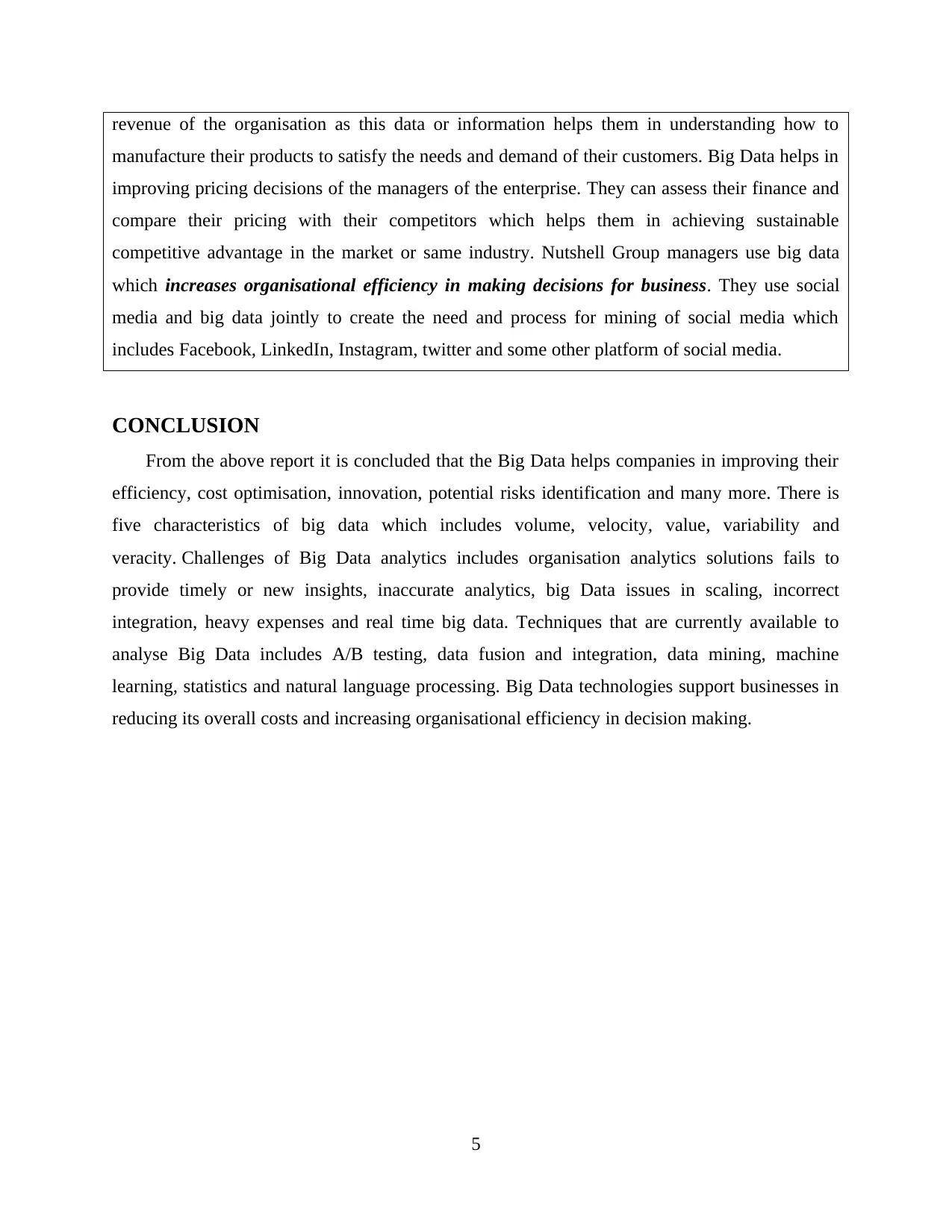
revenue of the organisation as this data or information helps them in understanding how to
manufacture their products to satisfy the needs and demand of their customers. Big Data helps in
improving pricing decisions of the managers of the enterprise. They can assess their finance and
compare their pricing with their competitors which helps them in achieving sustainable
competitive advantage in the market or same industry. Nutshell Group managers use big data
which increases organisational efficiency in making decisions for business. They use social
media and big data jointly to create the need and process for mining of social media which
includes Facebook, LinkedIn, Instagram, twitter and some other platform of social media.
CONCLUSION
From the above report it is concluded that the Big Data helps companies in improving their
efficiency, cost optimisation, innovation, potential risks identification and many more. There is
five characteristics of big data which includes volume, velocity, value, variability and
veracity. Challenges of Big Data analytics includes organisation analytics solutions fails to
provide timely or new insights, inaccurate analytics, big Data issues in scaling, incorrect
integration, heavy expenses and real time big data. Techniques that are currently available to
analyse Big Data includes A/B testing, data fusion and integration, data mining, machine
learning, statistics and natural language processing. Big Data technologies support businesses in
reducing its overall costs and increasing organisational efficiency in decision making.
5
manufacture their products to satisfy the needs and demand of their customers. Big Data helps in
improving pricing decisions of the managers of the enterprise. They can assess their finance and
compare their pricing with their competitors which helps them in achieving sustainable
competitive advantage in the market or same industry. Nutshell Group managers use big data
which increases organisational efficiency in making decisions for business. They use social
media and big data jointly to create the need and process for mining of social media which
includes Facebook, LinkedIn, Instagram, twitter and some other platform of social media.
CONCLUSION
From the above report it is concluded that the Big Data helps companies in improving their
efficiency, cost optimisation, innovation, potential risks identification and many more. There is
five characteristics of big data which includes volume, velocity, value, variability and
veracity. Challenges of Big Data analytics includes organisation analytics solutions fails to
provide timely or new insights, inaccurate analytics, big Data issues in scaling, incorrect
integration, heavy expenses and real time big data. Techniques that are currently available to
analyse Big Data includes A/B testing, data fusion and integration, data mining, machine
learning, statistics and natural language processing. Big Data technologies support businesses in
reducing its overall costs and increasing organisational efficiency in decision making.
5
Paraphrase This Document
Need a fresh take? Get an instant paraphrase of this document with our AI Paraphraser
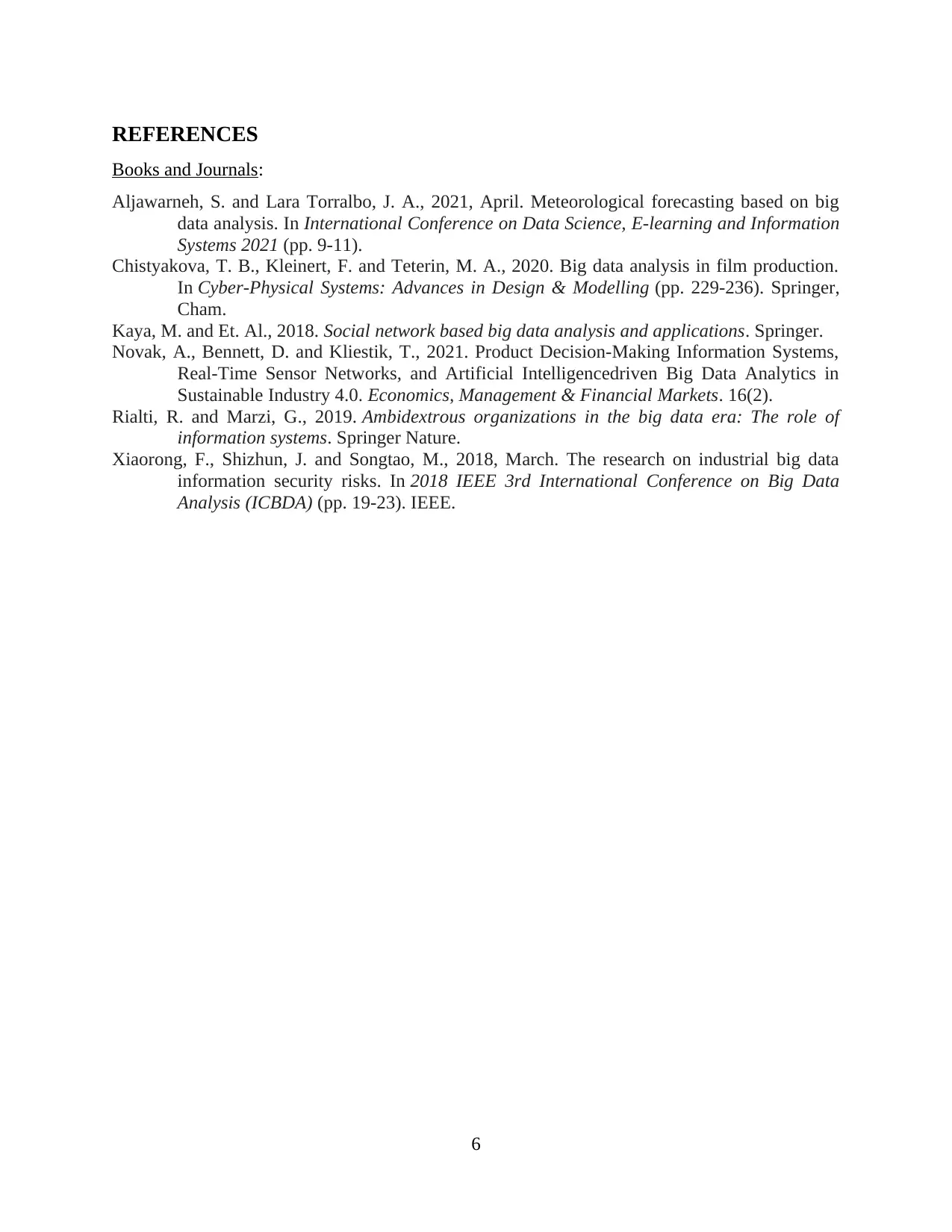
REFERENCES
Books and Journals:
Aljawarneh, S. and Lara Torralbo, J. A., 2021, April. Meteorological forecasting based on big
data analysis. In International Conference on Data Science, E-learning and Information
Systems 2021 (pp. 9-11).
Chistyakova, T. B., Kleinert, F. and Teterin, M. A., 2020. Big data analysis in film production.
In Cyber-Physical Systems: Advances in Design & Modelling (pp. 229-236). Springer,
Cham.
Kaya, M. and Et. Al., 2018. Social network based big data analysis and applications. Springer.
Novak, A., Bennett, D. and Kliestik, T., 2021. Product Decision-Making Information Systems,
Real-Time Sensor Networks, and Artificial Intelligencedriven Big Data Analytics in
Sustainable Industry 4.0. Economics, Management & Financial Markets. 16(2).
Rialti, R. and Marzi, G., 2019. Ambidextrous organizations in the big data era: The role of
information systems. Springer Nature.
Xiaorong, F., Shizhun, J. and Songtao, M., 2018, March. The research on industrial big data
information security risks. In 2018 IEEE 3rd International Conference on Big Data
Analysis (ICBDA) (pp. 19-23). IEEE.
6
Books and Journals:
Aljawarneh, S. and Lara Torralbo, J. A., 2021, April. Meteorological forecasting based on big
data analysis. In International Conference on Data Science, E-learning and Information
Systems 2021 (pp. 9-11).
Chistyakova, T. B., Kleinert, F. and Teterin, M. A., 2020. Big data analysis in film production.
In Cyber-Physical Systems: Advances in Design & Modelling (pp. 229-236). Springer,
Cham.
Kaya, M. and Et. Al., 2018. Social network based big data analysis and applications. Springer.
Novak, A., Bennett, D. and Kliestik, T., 2021. Product Decision-Making Information Systems,
Real-Time Sensor Networks, and Artificial Intelligencedriven Big Data Analytics in
Sustainable Industry 4.0. Economics, Management & Financial Markets. 16(2).
Rialti, R. and Marzi, G., 2019. Ambidextrous organizations in the big data era: The role of
information systems. Springer Nature.
Xiaorong, F., Shizhun, J. and Songtao, M., 2018, March. The research on industrial big data
information security risks. In 2018 IEEE 3rd International Conference on Big Data
Analysis (ICBDA) (pp. 19-23). IEEE.
6
1 out of 8
Related Documents
Your All-in-One AI-Powered Toolkit for Academic Success.
+13062052269
info@desklib.com
Available 24*7 on WhatsApp / Email
![[object Object]](/_next/static/media/star-bottom.7253800d.svg)
Unlock your academic potential
Copyright © 2020–2025 A2Z Services. All Rights Reserved. Developed and managed by ZUCOL.


